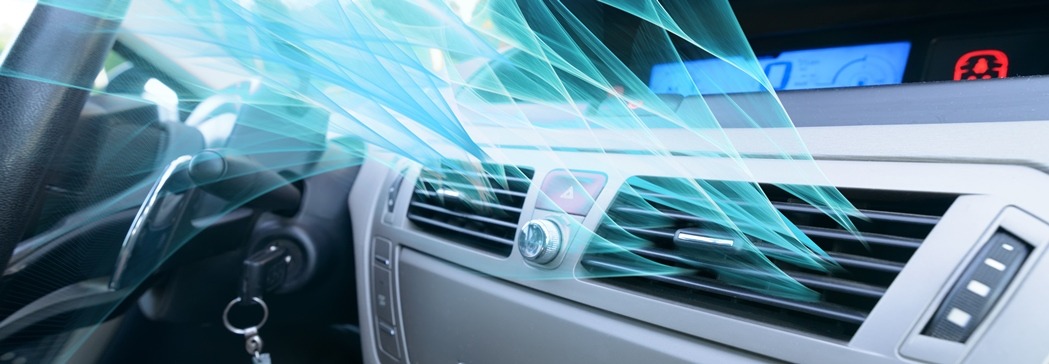
14 Mar Car Air Conditioning System Functions & Maintenance
 It looks like another hot summer is ahead, so schedule routine maintenance on your car air conditioning system before the temperatures soar. Recharging the automotive refrigerant can keep the cold air flowing in your car all summer. Keep reading to learn how your car air conditioning system works, the dangers of automotive refrigerant, and just how vital the HVAC components are to a well-working A/C system.
It looks like another hot summer is ahead, so schedule routine maintenance on your car air conditioning system before the temperatures soar. Recharging the automotive refrigerant can keep the cold air flowing in your car all summer. Keep reading to learn how your car air conditioning system works, the dangers of automotive refrigerant, and just how vital the HVAC components are to a well-working A/C system.
How A Car Air Conditioning System Functions
A car air conditioning system is a complex array of HVAC components that must work in unison to be effective. The compressor is basically a pump attached to your engine’s crankshaft. It compresses a refrigerant (low-pressure gas) into a high-pressure gas, creating heat. The condenser then cools down that hot, high-pressure gas, turning it into a liquid. During this process, condensation produces moisture and is removed via the receiver-dryer. Then, it travels through the thermal expansion valve (orifice tube), allowing the high-pressure liquid to expand.
The refrigerant is now a cold, low-pressure liquid that enters the evaporator (usually in the car’s cabin), absorbing the hot air inside it. A fan blows the cold air inside the cabin and the heat outside the vehicle. This process turns that cold, low-pressure liquid into a warm, low-pressure gas again, and the process repeats.
Vehicle HVAC Components
Let’s look deeper at the HVAC components in your car air conditioning system:
Compressor
The compressor is what starts the whole process of your air conditioning. If it wears out or becomes damaged, the air will still flow through the system but not cold. Unfortunately, replacing a faulty compressor is expensive. Expect to pay an auto shop $700 – $1500 (or more, depending on your specific car).
Condenser
The condenser looks and functions like a small radiator. It cools the hot liquid refrigerant moving through the many tubes. If any tubes inside the condenser are blocked, cracked, or broken, the fluid cannot move through the system or cool down. If the fluid stays hot, your car’s A/C will blow hot air into the interior instead of cold.
Evaporator
The evaporator is usually located in the car’s cabin and resembles a radiator. Its job is to absorb the heat from the air inside the car and take it outside. A fan blows on the cold coils generated by the low-pressure liquid; the coils absorb the heat from the air as it moves through the evaporator, leaving you with a cool interior. If there is an issue with the system before it reaches the evaporator, warm or hot air will blow into the car. The refrigerant must be a super cold low-pressure liquid to generate cold air.
Receiver-Dryer
The receiver-dryer is a small reservoir containing small grains (called desiccants) that attract water. It is important to ensure no water enters the evaporator since the refrigerant’s temperature can go below the water’s freezing point. While the refrigerant will not freeze, any frozen water crystals in the system can cause damage.
Thermal Expansion Valve (TXV) or Orifice Tube
The TXV and the orifice tube perform the same function, but your system will only have one of them. The TXV has moving parts that can wear out and require replacement, while the orifice tube has no moving parts but can get clogged with debris. Schedule an air conditioning service to keep your car’s A/C running correctly.
Automotive Refrigerant
Initially, auto manufacturers used Freon in most car air conditioning systems. However, environmentalists later determined that Freon harmed the ozone, so slightly safer alternatives (R-134a or HFC-134a) were developed and used in all cars after 1996.
If your vehicle is low on refrigerant, then that may be why the air conditioning is blowing hot air. It is a closed system, so low refrigerant means finding and repairing the leak. Severely low refrigerant levels can cause irreversible damage to the HVAC components. Leaking refrigerant is unsafe (according to the EPA) and can cause costly repairs if not addressed.
Recharging Auto Air Conditioning
If the refrigerant in your car air conditioning system is low, a service technician can top it off. However, if the level is too low, it must be recharged. This process includes draining, cleaning, and refilling the system with fresh refrigerant. Low refrigerant is a sign that more significant issues are at play. The technician should find the source of the leak and repair it.
Air Conditioning Maintenance & Repair
An excellent way to keep your HVAC components in good working order is to run your car’s A/C once a month for 10-15 minutes throughout the year. A compressor sitting idle too long can become compromised and not work when needed.
Schedule a Car Air Conditioning System Service
With over two decades of experience in automotive air conditioning service and repair, let JJ’s Auto Care technicians assist with all your HVAC needs from Automotive Refrigerant to HVAC Components repair. Visit us online or call (904) 721-6646 to schedule a car air conditioning

